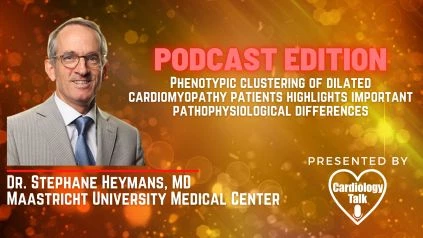Dr. Stephane Heymans, MD- Phenotypic clustering of dilated cardiomyopathy patients highlights important pathophysiolo...
Dr. Stephane Heymans studied public health at Harvard University in Cambridge. MA and now works at Maastricht University Medical Center in the Netherlands. In this video Dr. Heymans discusses the Phenotypic clustering of dilated cardiomyopathy patients highlights important pathophysiological differences.
Link to Abstract-
https://academic.oup.com/eurheartj/article/42/2/162/5959816
Abstract-
Dilated cardiomyopathy (DCM) is caused by a combination of hereditary and acquired factors. Until now, clinical decision-making in DCM has primarily been predicated on ejection fraction (EF) and NYHA categorization, with the DCM heterogeneity being overlooked. The goal of this work was to uncover pathophysiological differences between DCM subgroups by using phenotypic clustering to integrate aetiologies, comorbidities, and cardiac function along cardiac transcript levels.
Methods and outcomes-
We included 795 DCM patients from the Maastricht Cardiomyopathy Registry who were phenotyped in depth, which comprised extensive clinical data on aetiology and comorbodies, imaging, and endomyocardial biopsies. Based on unsupervised hierarchical clustering of principal components, four mutually exclusive and clinically different phenogroups (PG) were identified: [PG1] moderate systolic dysfunction, [PG2] auto-immune, [PG3] genetic and arrhythmias, and [PG4] severe systolic dysfunction. Pro-inflammatory (PG2, auto-immune), pro-fibrotic (PG3; arrhythmia), and metabolic (PG4, reduced EF) gene expression were found in cardiac samples (n = 91). Furthermore, even after accounting for well-known clinical indicators, event-free survival differed between the four phenogroups. Decision tree modeling identified four clinical parameters (autoimmune disease, EF, atrial fibrillation, and kidney function) by which every DCM patient from two independent DCM cohorts could be assigned to one of four phenogroups with corresponding outcomes (n = 789; Spain, n = 352, and Italy, n = 437), demonstrating the phenogrouping's applicability.
Conclusion-
The current investigation found four distinct DCM phenotypes, each with distinct clinical presentations, underlying molecular profiles, and outcomes, paving the door for a more individualized treatment approach.



